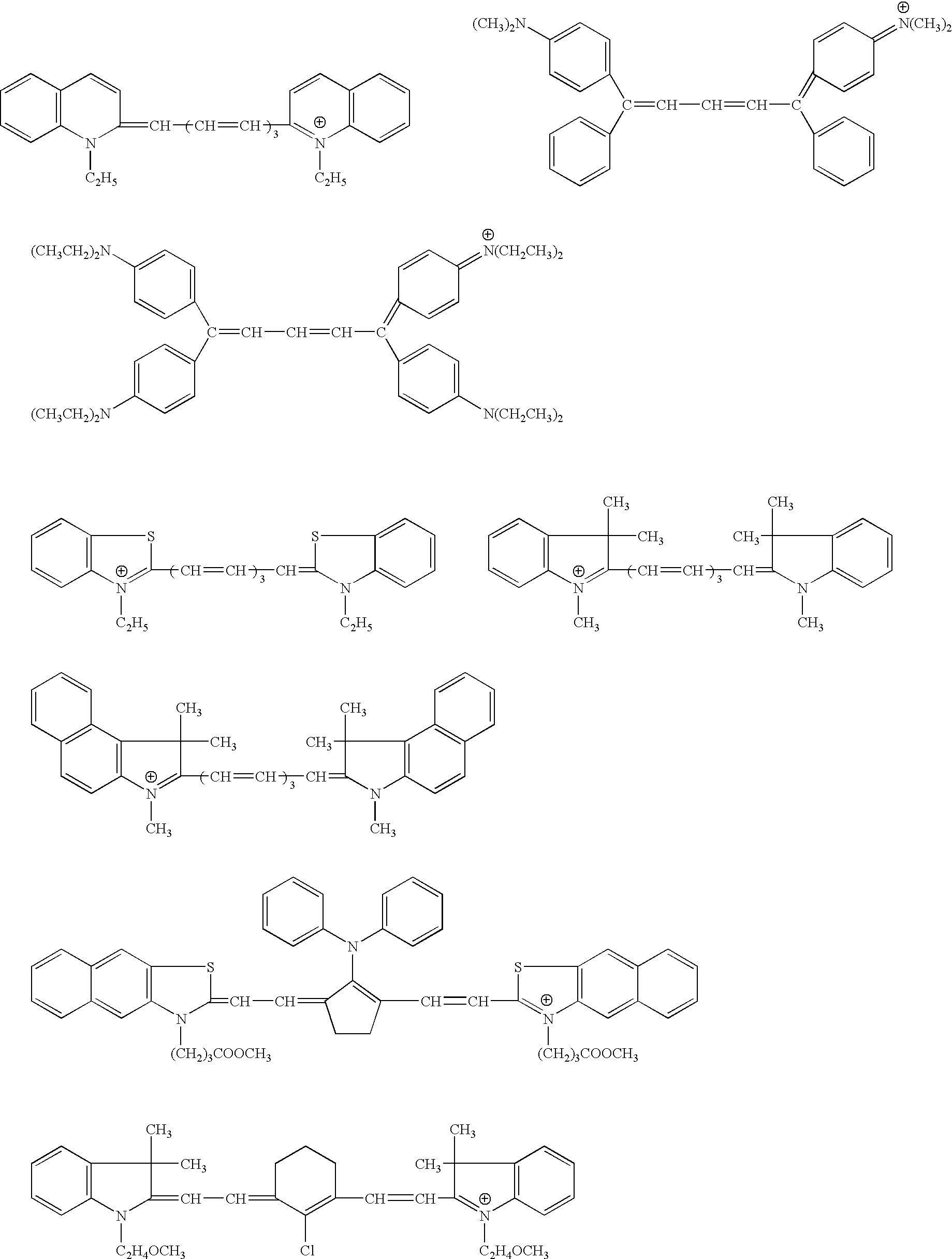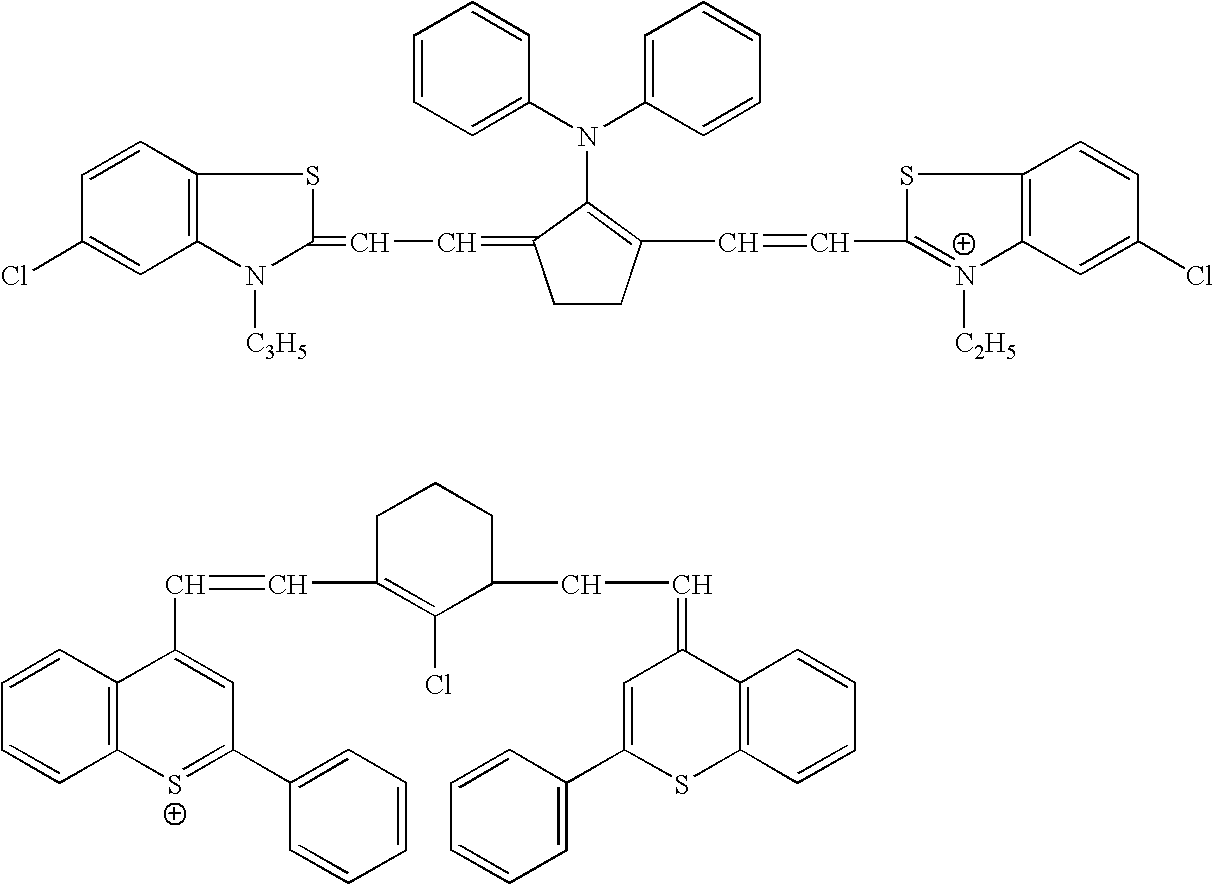Negative photosensitive composition and negative photosensitive lithographic printing plate
a technology of composition and lithographic printing plate, which is applied in the direction of thermography, instruments, photosensitive materials, etc., can solve the problems of deterioration of printing durability, low sensitivity, and inferior printing durability, and achieve excellent printing durability, high sensitivity, and high adhesion.
- Summary
- Abstract
- Description
- Claims
- Application Information
AI Technical Summary
Benefits of technology
Problems solved by technology
Method used
Image
Examples
example 1
[0116]As shown in the formulation in Table 1, 0.2 g (2% by weight) of a near infrared absorbable cationic dye (A-1) represented by the following formula (A-1) as the infrared absorber (A), 0.6 g (6% by weight) of an organoboron compound (B-1) represented by the following formula (B-1) as the organoboron compound (B), 3.0 g (30% by weight) of a polyfunctional urethane acrylate (manufactured by Bomar Co., UR-3447) as the compound having a polymerizable unsaturated group (C), 0.9 g (9% by weight) of a 2-hydroxy-4-methoxybenzophenone-5-sulfonate of a condensate of paradiazodiphenylamine and formaldehyde as the diazo resin (D), 4.8 g (48% by weight) of an acrylic resin (E-1), which is an alkali-soluble resin, as the binder resin (E), 0.2 g of DC-190 (10%, ethylene glycol monomethyl ether solution, manufactured by Eastman Kodak Company) as the surfactant, and 0.3 g of Crystal Violet as the colorant were dissolved in a solvent mixture of 70.0 g of ethylene glycol monomethyl ether and 20.0 ...
examples 2 and 3
, Comparative Examples 1 to 4
[0121]In the same manner as in Example 1, except that the formulation of the coating solution was changed as shown in Table 1, negative-working photosensitive lithographic printing plates were produced and evaluated. The results are shown in Table 2. The organoboron compound (B-2) in the Table 1 has a structure represented by the following formula (B-2), and the near infrared absorbable cationic dye (A-2) has a structure represented by the following formula (A-2).
[0122]
TABLE 1Coating solution of negative-working photosensitive compositionUnit: gExamplesComparative Examples1231234Near infrared absorbable cationic dye (A-1)0.20.20.20.20.20.2Near infrared absorbable cationic dye (A-2)0.2Organoboron compound (B-1)0.60.60.60.60.6Organoboron compound (B-2)0.6Polyfunctional urethane acrylate3.03.03.03.03.03.02-hydroxy-4-methoxybenzophenone-5-sulfonate of0.90.90.90.9condensate of paradiazodiphenylamine with formaldehydep-toluenesulfonate of condensate of0.9parad...
example 4
[0126]As shown in the formulation in Table 3, 0.2 g (2% by weight) of a near infrared absorbable cationic dye (A-1) represented by the following formula (A-1) as the infrared absorber (A), 0.6 g (6% by weight) of an organoboron compound (B-1) represented by the following formula (B-1) as the organoboron compound (B), 3.0 g (30% by weight) of a polyfunctional urethane acrylate. (manufactured by Bomar Co., UR-3447) as the compound having a polymerizable unsaturated group (C), 0.9 g (9% by weight) of a 2-hydroxy-4-methoxybenzophenone-5-sulfonate of a condensate of paradiazodiphenylamine and formaldehyde as the diazo resin (D), 4.8 g (48% by weight) of the above polyurethane resin, which is an alkali-soluble resin, as the binder resin (E), 0.2 g of DC-190 (10%, ethylene glycol monomethyl ether solution, manufactured by Eastman Kodak Company) as the surfactant, and 0.3 g of Crystal Violet as the colorant were dissolved in a solvent mixture of 70.0 g of ethylene glycol monomethyl ether an...
PUM
| Property | Measurement | Unit |
|---|---|---|
| wavelength | aaaaa | aaaaa |
| particle diameter | aaaaa | aaaaa |
| particle diameter | aaaaa | aaaaa |
Abstract
Description
Claims
Application Information
 Login to View More
Login to View More - R&D
- Intellectual Property
- Life Sciences
- Materials
- Tech Scout
- Unparalleled Data Quality
- Higher Quality Content
- 60% Fewer Hallucinations
Browse by: Latest US Patents, China's latest patents, Technical Efficacy Thesaurus, Application Domain, Technology Topic, Popular Technical Reports.
© 2025 PatSnap. All rights reserved.Legal|Privacy policy|Modern Slavery Act Transparency Statement|Sitemap|About US| Contact US: help@patsnap.com



